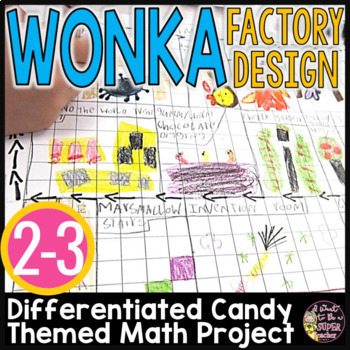Charlie and the Chocolate Factory Math | Fun Math Projects | Willy Wonka Math
- Zip
What educators are saying
Also included in
- Getting ready for some end of the year fun with Charlie and the Chocolate Factory? This BRAND NEW BUNDLE will add some engaging PRINT & GO + DIGITAL Willy Wonka and the Chocolate Factory math activities to your Charlie and the Chocolate Factory novel study or classroom Wonka Week! Save over 45%Price $17.99Original Price $39.47Save $21.48
Description
Add some Willy Wonka and the Chocolate Factory math project FUN to your end of the year 2nd or 3rd grade plans! This candy-themed math project is a perfect way to integrate math with a class reading of Charlie and the Chocolate Factory, or to use as a stand alone enrichment project during your measurement unit or class Wonka Week.
With three differentiated versions, this activity is ready to PRINT & GO for your second or third grade students. Editable versions are included for easy customization!
**This product has recently been updated with a challenge version of the design project + area and perimeter printables for each version of the activity. Please redownload for the newest updates!**
In this Wonka Factory math activity students are asked to design a new floor for Willy Wonka's factory. They must use measurement and problem solving skills to create a factory map of required rooms + some of their own.
This is a perfect activity to review measurement skills, perimeter, area, and/or working effectively with groups. Students love talking about all their ideas for rooms in the factory (cupcake lake! marshmallow bouncy room!) and you'll love how engaged they are with measurement skills.
Included with this activity:
- Teacher notes and instructions
- Instruction letter from Willy Wonka outlining design task (simpler version)
- Room information sheet (simpler version)
- Graph paper (15x12)
- Instruction letter from Willy Wonka outlining design task (grade-level version)
- Room information sheet (grade-level version)
- Graph paper (30x18)
- Room information sheet (challenge version)
- Graph paper (33x21)
- Perimeter & area problem page (aligns with versions 1 & 2)
- Perimeter & area problem page (aligns with challenge version)
- Perimeter & area problem answer keys
- Four examples of finished student work
- Editable versions of the letters, room information pages, and design paper for easy customization (clip art is not moveable due to copyright restrictions)
The ZIP file you'll receive after purchase includes:
- 1 PDF document of the print and go materials
- 1 PowerPoint with editable versions of the student letters, room information sheets, and design paper pages with and without clip art
Activity Instructions:
This activity typically takes 3-4 days if students use the included graph paper. If you choose to have them use blank construction paper it can be a week long activity.
Day 1
Students read the letter and brainstorm ideas for additional rooms. They can also start a sketch to help them plan how they might like to arrange the required rooms for the floor. Most students will want to talk about all their amazing ideas for candy-based rooms for the factory.
Day 2
Have blank art paper (much more difficult!) or graph paper available for students. They can start arranging and labeling the required rooms. You will want more than one graph paper per student.
Day 3+
Have students share how they have decided to place the required rooms and how much room they have left for their own ideas. Did students randomly place rooms or organize them in 3 rows to maximize space?
My students always want to decorate every room with furniture, marshmallows, and gummy bears. Before they do this we talk about how architects draw their plans as a bird’s eye view.
Have students find the perimeter and/or area of each of the rooms if time allows.
Check out the preview to see if this would be a helpful activity for your class. I use this as a fun activity to do during WONKA Week (read more about Wonka Week at the Super Teacher blog here), testing weeks or as a measurement math review.
Have a fab day Super Teacher!
Katie
Sign up for the Super Teacher e-mail list and be the first to know about exclusive freebies, new products, and get super teacher tips and tricks for your teacher toolbox delivered right to your inbox!
If you like this product you might also like:
Wonka Math Challenges and Brainteasers
Ready, Set, Show! Wonka Addition Facts
Ready, Set, Show! Wonka Subtraction Facts
Ready, Set, Show! Wonka Addition & Subtraction Facts
Ready, Set, Show! Wonka Multiplication Facts
Ready, Set, Show! Wonka Division Facts
Ready, Set, Show! Wonka Multiplication & Division Facts
Become a follower and be the first to know about new Super Teacher freebies and product launches. It's Easy!
Click HERE to become a follower. You will then receive customized email updates from TpT when I upload new products to my store. I typically give a 20% discount on all new products for the first 48 hours, so please follow and get in on the discounted fun. Nothing’s better than saving some moolah!
Get TPT credit to use on future purchases. It's FREE!
Go to your “My Purchases” page (you may need to login). Beside each purchase you'll see a blinking “Provide Feedback” option. Simply click it and you will be taken to a page where you can give a quick rating and leave a short comment for the product. I love reading your comments and value your feedback greatly as it helps me determine which products are most valuable for your classroom so I can create more for you!






